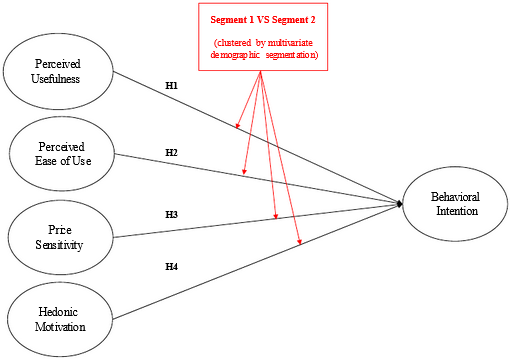Hey there, fellow marketers! Have you ever wondered how top e-commerce brands are acing their SMS and chat app marketing game? The secret sauce is behavioral segmentation. I'm on cloud nine to spill the beans about what I've learned with you. Together, we'll solve your marketing challenges and skyrocket your e-commerce business to new heights!
In this article, we'll delve deep into the world of behavioral segmentation, exploring various psychological studies, and I'll share practical examples from successful e-commerce companies. We'll also touch on the pros and cons of marketing segmentation and its comparison with behavioral segmentation. Fasten your seatbelts, folks – we're hitting the road!
1. Understanding behavioral segmentation and its benefits
Imagine cutting your customer base into little pieces based on what they're up to – like what they're buying, how they're using your stuff, and how chummy they are with your brand. That's behavioral segmentation for you! By doing so, you can tailor your SMS and chat app marketing to resonate with each segment, ultimately driving higher engagement and conversion rates.
Comparison with marketing segmentation
Marketing segmentation, on the other hand, is a broader concept that includes dividing your customers based on demographics, psychographics, geographics, and, of course, behavior. While marketing segmentation is a crucial first step, behavioral segmentation allows you to hone in on specific actions that can help you create more targeted and effective campaigns.
Pros and cons
Pros of behavioral segmentation:
- Allows for personalized messaging
- Boosts customer engagement
- Increases conversion rates
- Enhances customer retention
Cons of behavioral segmentation:
- Requires data collection and analysis
- May lead to an overwhelming number of segments
- Can be time-consuming
Pros and cons of marketing segmentation
Pros of marketing segmentation (demographical, psychographical, geographical, etc.):
- Helps identify target markets and customer personas
- Enables more focused marketing strategies
- Improves resource allocation by targeting specific groups
- Enhances overall marketing effectiveness
Cons of marketing segmentation (demographical, psychographical, geographical, etc.):
- May overlook individual customer behavior and preferences
- Requires continuous updating as markets and customer preferences evolve
- Potential for oversimplification of customer segments
- Less targeted and personalized compared to behavioral segmentation
Dealing with the cons of behavioral segmentation
- Requires data collection and analysis:
- Solution: Invest in customer relationship management (CRM) and data analytics tools to automate data collection and analysis. By streamlining these processes, you can minimize the time and effort required to segment your customers effectively.
- May lead to an overwhelming number of segments:
- Solution: Focus on identifying the most impactful and relevant segments for your business. Strike a balance between granularity and manageability by grouping customers with similar behaviors and targeting them with tailored marketing campaigns.
- Can be time-consuming:
- Solution: Leverage marketing automation platforms to automate the delivery of personalized messaging to different customer segments. By automating your behavioral segmentation efforts, you can save time while still providing a highly targeted and personalized customer experience.
Dealing with the cons of marketing segmentation (demographical, psychographical, geographical, etc.)
- May overlook individual customer behavior and preferences:
- Solution: Combine marketing segmentation with behavioral segmentation to create a more comprehensive view of your customers. This approach allows you to target specific customer groups while also considering their individual actions and preferences.
- Requires continuous updating as markets and customer preferences evolve:
- Solution: Regularly review and update your customer segments to ensure they remain relevant and accurately reflect the evolving market landscape. Stay informed about market trends and customer feedback to make data-driven adjustments to your segmentation strategy.
- Potential for oversimplification of customer segments:
- Solution: Use a combination of segmentation criteria, such as demographics, psychographics, geographics, and behavior, to create more nuanced customer segments. By incorporating multiple data points, you can avoid oversimplifying your customer groups and ensure your marketing efforts are highly targeted.
- Less targeted and personalized compared to behavioral segmentation:
- Solution: Adopt a blended approach by incorporating both marketing and behavioral segmentation in your overall marketing strategy. This way, you can leverage the strengths of each method while minimizing their respective drawbacks, resulting in a more effective and targeted marketing campaign.
Example from practice: Amazon's personalized recommendations based on a user's browsing and purchase history is an excellent example of behavioral segmentation in action. By targeting customers with relevant product suggestions, Amazon has successfully increased its sales and customer loyalty.

2. The psychology behind customer behavior
Understanding the psychological factors that influence customer behavior is crucial for effective behavioral segmentation. Some key concepts include:
- Cognitive dissonance: When customers experience discomfort due to inconsistent beliefs, they may seek ways to reduce this discomfort. By understanding this, marketers can craft messaging that helps customers justify their purchases and reduce dissonance.
- Reciprocity: Customers are more likely to respond positively to marketing messages if they feel they've received something of value first. Offering free content, discounts, or exclusive deals can trigger this sense of reciprocity and lead to increased engagement and conversions.
- Social proof: People are more likely to adopt behaviors that they see others around them adopting. By showcasing customer testimonials, reviews, or user-generated content, you can tap into this powerful psychological principle and increase the likelihood of your customers taking action.
- Scarcity: The fear of missing out (FOMO) can be a strong motivator for customers to take action. Limited-time offers, exclusive deals, and countdown timers can all create a sense of urgency and drive customers to act.
3. Identifying key behavioral segments for e-commerce
To master behavioral segmentation, it's crucial to identify the primary segments relevant to your e-commerce business. Some key segments include:
- New customers
- Repeat customers
- High spenders
- Cart abandoners
- Inactive customers
- Engaged users
Example from practice: Zappos, the popular online shoe retailer, recognizes its high spenders and rewards them with special offers and exclusive deals. This targeted approach not only keeps their best customers engaged but also encourages them to spend more.
4. Leveraging SMS and chat app marketing for behavioral segmentation
SMS and chat apps offer a direct and personal way to communicate with your customers. Here are some ways you can leverage these channels for behavioral segmentation:
- Send personalized welcome messages to new customers
- Offer exclusive discounts and promotions to repeat customers
- Recover abandoned carts with timely reminders
- Re-engage inactive customers with enticing offers
- Provide customer support through chat apps
Example from practice: Dollar Shave Club, a subscription-based razor company, sends personalized SMS messages to customers who have abandoned their carts. This tactic not only helps recover lost sales but also strengthens the customer-brand relationship.

5. Incorporating psychological triggers in your SMS and chat app marketing
By understanding the psychological principles that influence customer behavior, you can craft more effective messaging for your SMS and chat app marketing campaigns. Some tactics include:
-
Use storytelling to create an emotional connection with your customers: Stories are a powerful tool for creating an emotional bond with your audience. They can help humanize your brand and make your messaging more relatable and memorable.
Best approach: Craft compelling narratives that showcase the benefits of your product or service, highlight customer success stories, or share the story behind your brand. Use emotive language and vivid descriptions to engage your audience and make a lasting impression.
Tools: Storytelling platforms like StoryChief and Contently can help you create and distribute engaging stories across your marketing channels.
Example from practice: TOMS, the socially-conscious shoe company, shares stories of the communities they impact with their "One for One" business model. By connecting customers with the positive impact of their purchases, TOMS creates an emotional connection and encourages brand loyalty.
-
Offer social proof by highlighting customer testimonials or reviews: Social proof is the psychological phenomenon where people are more likely to adopt a certain behavior if they see others doing the same. Showcasing positive customer reviews or testimonials can build trust and credibility for your brand.
Best approach: Collect and display customer reviews, testimonials, and case studies in your SMS and chat app marketing messages. Use quotes, statistics, or ratings to provide concrete evidence of your product's value and success.
Tools: Platforms like Trustpilot, Yotpo, and Bazaarvoice can help you collect, manage, and showcase customer reviews.
Example from practice: Glossier, a popular beauty brand, frequently shares customer reviews and testimonials in their marketing campaigns. By showcasing real customers' positive experiences, Glossier builds trust and encourages potential customers to try their products.
-
Incorporate scarcity and urgency by offering limited-time deals or promotions: Scarcity and urgency are powerful psychological triggers that can encourage customers to act quickly to avoid missing out on a deal or opportunity.
Best approach: Create time-sensitive promotions or exclusive offers, and use language that emphasizes the limited availability. Include clear calls-to-action and deadlines in your messaging to prompt immediate action.
Tools: SMS and chat app marketing platforms like BulGate, ManyChat, and MobileMonkey can help you send targeted, time-sensitive messages to your customers.
Example from practice: Groupon, the online deals platform, uses scarcity and urgency in its marketing messages by offering limited-time deals and displaying the number of deals already claimed. This approach encourages customers to act quickly to avoid missing out.
-
Leverage the power of reciprocity by providing valuable content or exclusive offers: Reciprocity is the principle that when someone does something for us, we feel compelled to return the favor. By offering your customers valuable content or exclusive offers, you can foster goodwill and encourage them to engage with your brand.
Best approach: Share useful resources, such as how-to guides, eBooks, or webinars, with your customers via SMS or chat app messages. Offer exclusive discounts, promotions, or early access to new products as a reward for their loyalty.
Tools: Content marketing platforms like HubSpot, CoSchedule, and Outgrow can help you create and share valuable content with your audience.
Example from practice: Dropbox, the cloud storage service, offers additional storage space to users who refer friends to the platform. This approach leverages the principle of reciprocity, as users feel motivated to share Dropbox with their network in return for a valuable reward.
By incorporating these psychological triggers into your SMS and chat app marketing, you can create messaging that resonates with your customers on a deeper level, driving higher engagement and conversion rates.
-
Use personalization to make your customers feel special and valued: Personalization is the process of tailoring your marketing messages to address individual customers based on their preferences, behavior, or needs. By jazzing up your messages with a personal touch, you’ll be building bridges to your customers’ hearts. It’s like giving them a virtual high-five - they’ll feel cherished and totally get that you’re on their wavelength.
Best approach: Collect customer data, such as purchase history, preferences, and browsing behavior, to create individualized marketing messages. Address customers by their first name and include personalized recommendations or offers based on their unique interests and needs.
Tools: Personalization tools like Dynamic Yield, Segment, and Optimizely can help you create tailored marketing messages for your SMS and chat app campaigns.
Example from practice: Netflix, the streaming platform, uses personalization in its marketing messages by recommending shows and movies based on a user's viewing history. This approach ensures that users receive content that is relevant and interesting to them, increasing engagement and satisfaction.
-
Utilize the principle of consistency and commitment by encouraging small actions: The principle of consistency and commitment states that people are more likely to commit to a larger action if they have already taken a smaller, related action. By encouraging small actions from your customers, you can build momentum towards larger commitments, such as making a purchase or signing up for a subscription.
Best approach: Give your customers a gentle nudge to take baby steps with low-stake actions, like subscribing to your newsletter, grabbing a freebie, or taking part in a quick survey. Once they have taken these initial steps, follow up with targeted messaging that encourages them to take the next step in the customer journey, like making a purchase or upgrading their account.
Tools: Tools like Mailchimp, SurveyMonkey, and Typeform can help you create and distribute engaging content and surveys to encourage small actions from your customers.
Example from practice: Evernote, the note-taking app, encourages new users to create their first note or notebook as a small, initial action. By building on this commitment, Evernote can then follow up with targeted messaging that promotes the benefits of upgrading to their premium subscription.
Incorporating these psychological triggers in your SMS and chat app marketing can help you create more impactful campaigns that resonate with your customers on a deeper level. By understanding the motivations and preferences of your target audience, you can craft messages that drive higher engagement, conversion, and loyalty.
Customer loyalty is considered by many researchers and managers as one of the key factors for the success of a company. Loyal customers have a positive relationship with the company, spread positive references or reduce the cost of sales and thus represent a potential competitive advantage. These facts take on even greater importance in the rapidly evolving field of e-commerce, which has given rise to the term e-loyalty. (Kvíčala, Daniel & Starzyczná, Halina. (2023). Loyalty in E-Commerce. 10.1007/978-3-031-23574-0_3.)
Example from practice: Airbnb, the popular home-sharing platform, sends personalized messages to its users featuring stories of hosts and travelers, creating an emotional connection and encouraging users to book their next stay.

6. Advanced behavioral segmentation techniques for e-commerce
To take your behavioral segmentation strategy to the next level, consider incorporating advanced techniques such as:
-
Predictive analytics: Utilize customer data to predict future behaviors and tailor your marketing efforts accordingly. Predictive analytics involves using machine learning algorithms and statistical models to analyze historical data and make predictions about customer preferences, purchase intent, or the likelihood of churn.
Best approach: Collect and analyze data from various customer touchpoints, such as purchase history, browsing behavior, and interactions with your marketing campaigns. Mine this treasure trove of data for golden nuggets like patterns and trends, and you’ve got yourself a treasure map to a killer marketing strategy.
Tools: Some popular predictive analytics tools include IBM SPSS Modeler, RapidMiner, and Alteryx.
Example from practice: Spotify, the music streaming platform, uses predictive analytics to analyze user listening habits and create personalized playlists, such as "Discover Weekly" and "Daily Mix." This approach ensures users receive relevant content, increasing engagement and loyalty.
-
Customer journey mapping: Understand the different stages of your customer's journey and target them with relevant messaging at each stage. A customer journey map is a visual representation of the various touchpoints and experiences customers go through when interacting with your brand, from initial awareness to purchase and beyond.
Best approach: Identify key stages in the customer journey, such as awareness, consideration, purchase, retention, and advocacy. Analyze customer behavior and preferences at each stage, and create targeted marketing campaigns to guide them through the journey.
Tools: Customer journey mapping tools include Smaply, UXPressia, and Lucidchart.
Example from practice: Casper, the online mattress retailer, uses customer journey mapping to identify opportunities for targeted messaging. For example, they send educational content to customers in the awareness stage and offer personalized promotions to those in the consideration stage.
-
A/B testing: Test different messaging approaches to determine which resonates best with your target segments. Picture A/B testing as a marketing gladiator arena – two messages enter, but only one leaves victorious. Which SMS, email, or chat message gets the thumbs up for engagement, conversion, or other cool wins?
Best approach: Start by identifying a clear hypothesis, such as "Version A will have a higher click-through rate than Version B." Create two variations of your marketing message that differ in a single aspect, such as the subject line, offer, or call-to-action. Send these messages to two randomly selected groups of customers from the same segment and analyze the results to determine which variation is more effective.
Tools: Some popular A/B testing tools for SMS and chat app marketing include Braze, Leanplum, and Iterable.
Example from practice: Booking.com, the online travel booking platform, frequently uses A/B testing to optimize its messaging strategy. By testing different subject lines, offers, and calls-to-action, Booking.com can determine which messages resonate best with their target segments and drive higher engagement and conversions.
By mixing in these cutting-edge behavioral segmentation tricks into your e-commerce marketing cauldron, you'll have a magic potion that reveals your customers' deepest desires and concocts laser-focused, data-savvy campaigns.

Example from practice: Practice: Netflix, that oh-so-addictive binge-watch paradise, has some tricks up its sleeve. Using some kind of crystal ball called predictive analytics, it dishes out recommendations based on what you’ve watched before – serving up a tailor-made platter of TV goodness just for you.
7. Measuring the success of your behavioral segmentation efforts
Alright, let's get down to the nitty-gritty! For your behavioral segmentation quest, you've got to keep tabs on a couple of super important metrics. Let's break it down:
- Open and click-through rates: First up is the open rate, and that's basically the headcount of how many peeps are actually popping open your SMS or chat messages. But wait, there’s more! Click-through rate, or CTR for those in the know, is like a backstage pass into how many customers are jazzed enough to click on a link you’ve tucked inside your message. It’s the digital equivalent of ‘I’m listening, tell me more!’.
- Conversion rates: This is like your magic success number. It's the slice of your customers who go for the gold by buying, signing up, or jumping on a special deal. This metric is vital for measuring the effectiveness of your behavioral segmentation strategy in driving customers towards your desired goals. A high conversion rate indicates that your targeted messaging is successfully motivating your customers to take action.
- Average order value (AOV): AOV is the average amount spent by customers per transaction. This metric helps you understand how much customers are willing to spend with your brand and can indicate the success of your targeted promotions and messaging. By segmenting customers based on their spending behavior, you can tailor your marketing efforts to encourage higher spending from specific segments, resulting in an increased AOV.
- Customer retention rates: Customer retention rate is the percentage of customers who continue to engage with your brand and make repeat purchases over a specified period. This metric is crucial for evaluating the effectiveness of your behavioral segmentation strategy in nurturing long-term customer relationships. A high customer retention rate implies that your personalized messaging and targeted promotions are fostering loyalty and keeping customers engaged with your brand.
- Customer lifetime value (CLV): CLV is the total revenue you can expect from a customer over the entire duration of their relationship with your brand. This little number whispers sweet nothings about your customers’ lifelong worth and helps you dole out your resources like a boss. By using behavioral segmentation to target customers with personalized messaging and offers, you can enhance their overall experience with your brand, resulting in a higher CLV.
Example from practice: Etsy, the online marketplace for handmade goods, regularly analyzes its customer data to measure the success of its behavioral segmentation strategies. By doing so, Etsy can refine its marketing efforts and make data-driven decisions to grow its business.
In summary
Behavioral segmentation is a powerful tool that can revolutionize your e-commerce SMS and chat app marketing. By cracking the code on your customers' moves, getting into their headspace, and crafting messages that groove with their vibes, you're set to amp up engagement, reel in conversions, and keep them coming back for more.
Remember, you don't have to tackle behavioral segmentation alone. We're in this together! Embrace the process, learn from successful examples, and continuously measure and refine your strategies. Keep your eyes on the prize and a data-crunching hat on, and you'll be blazing trails on your journey to e-commerce stardom.
So go ahead, step out of your comfort zone, and let behavioral segmentation transform your marketing approach. The payoff could be ginormous – your e-commerce venture will wanna throw a parade in your honor! Time to get down to brass tacks, plunge into the deep end of customer data, and shake things up! Good luck, and happy segmenting!
